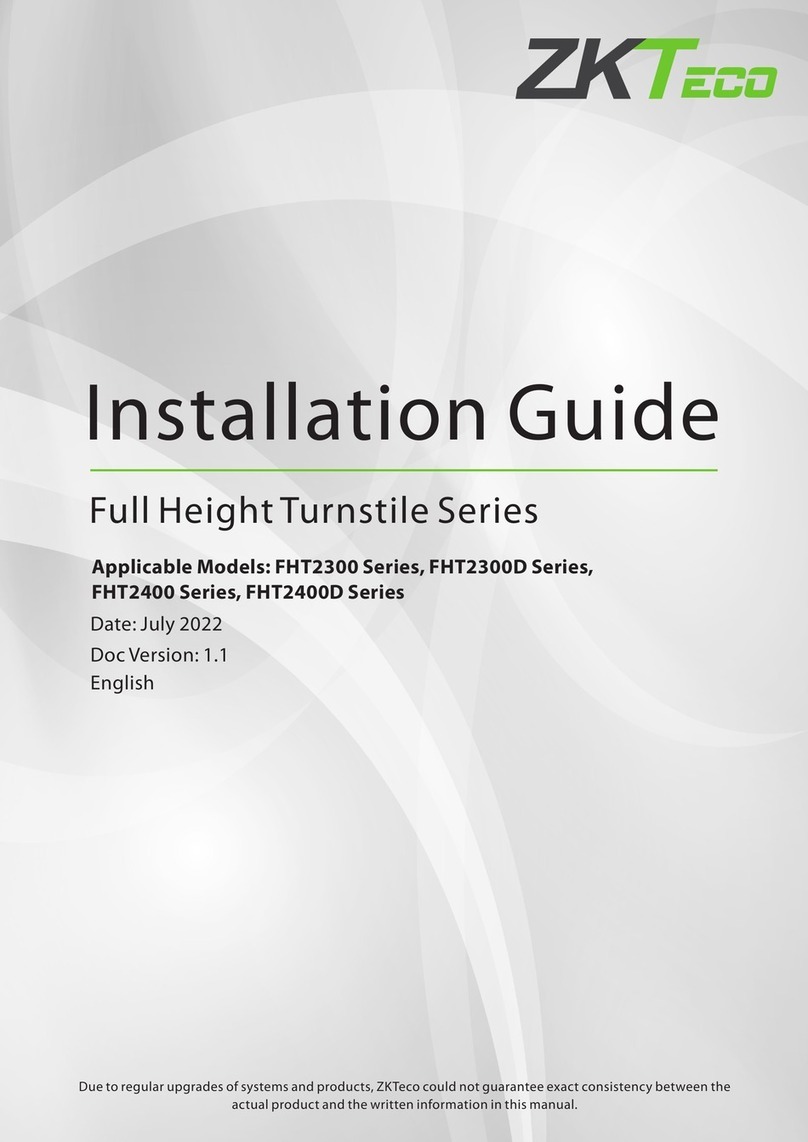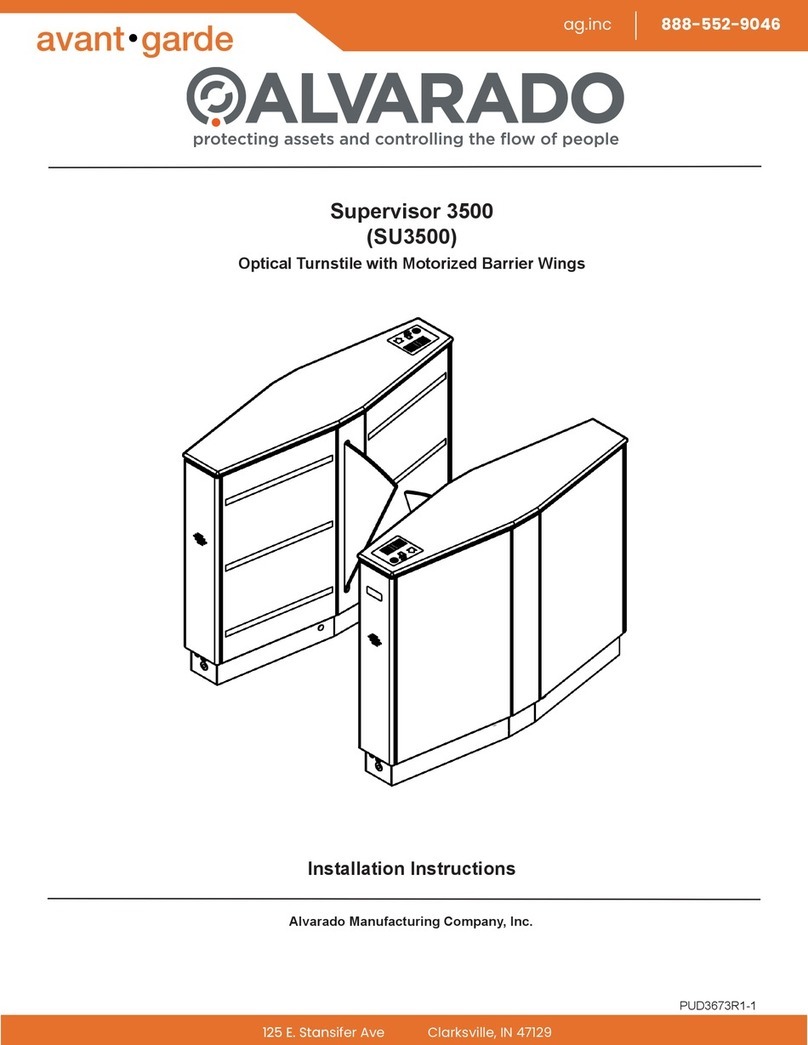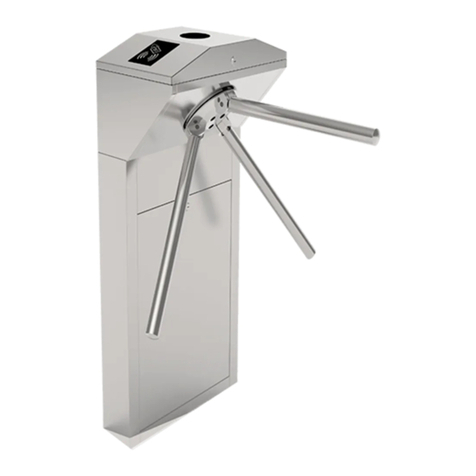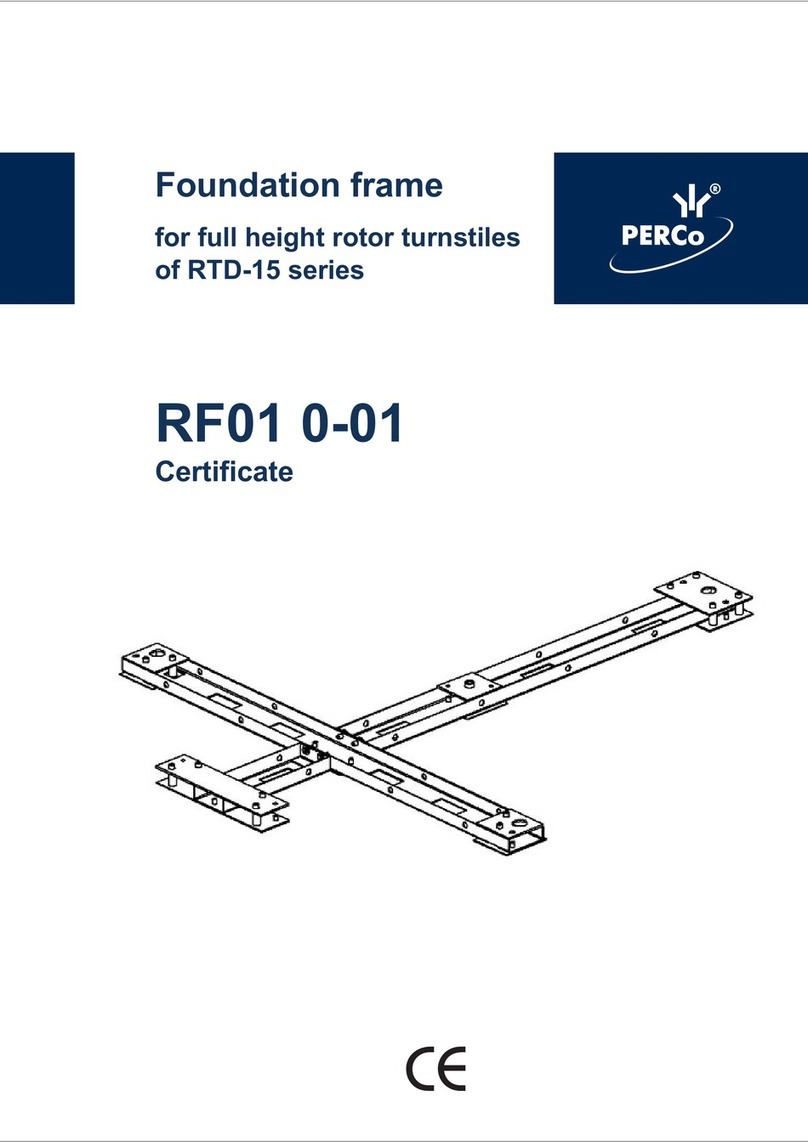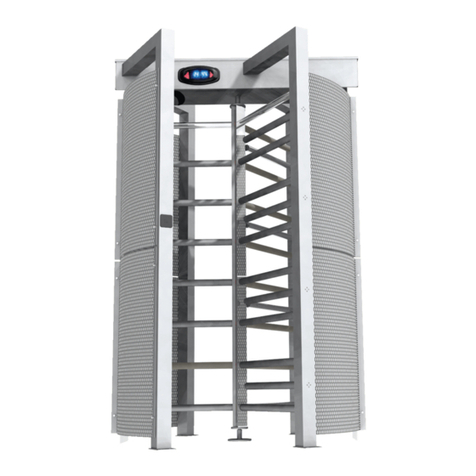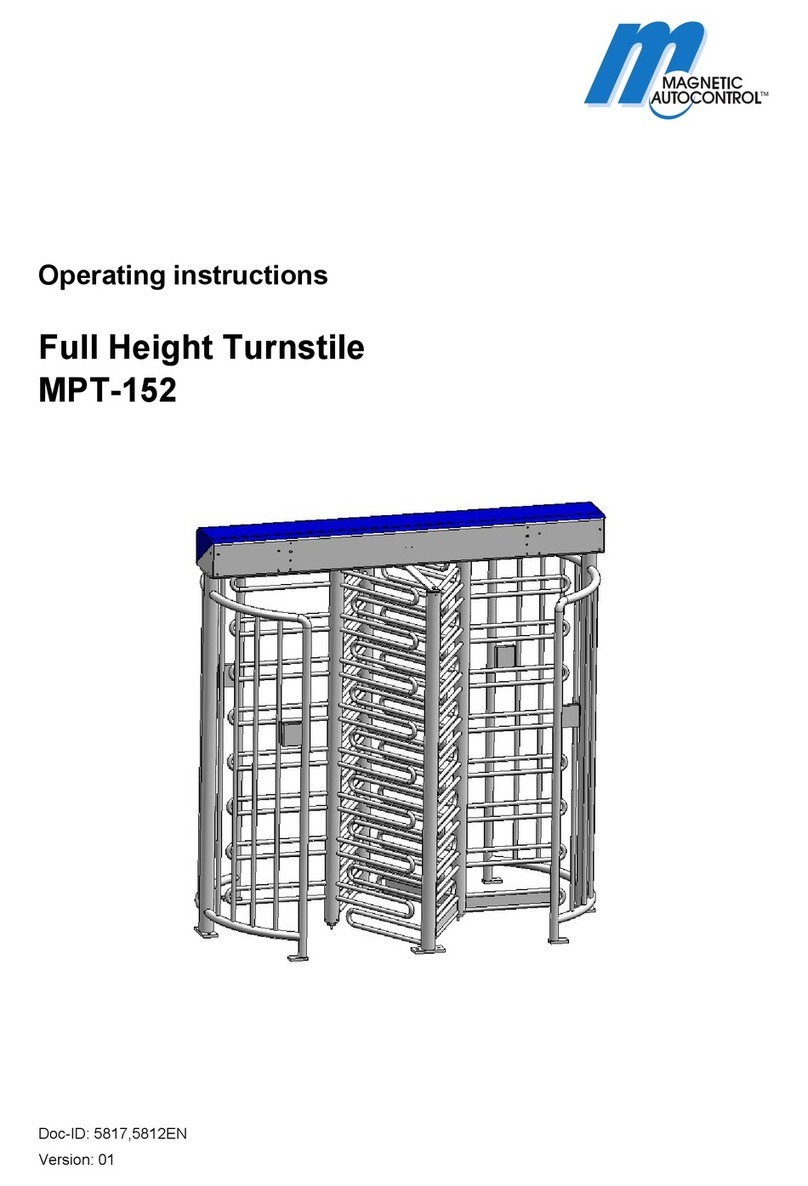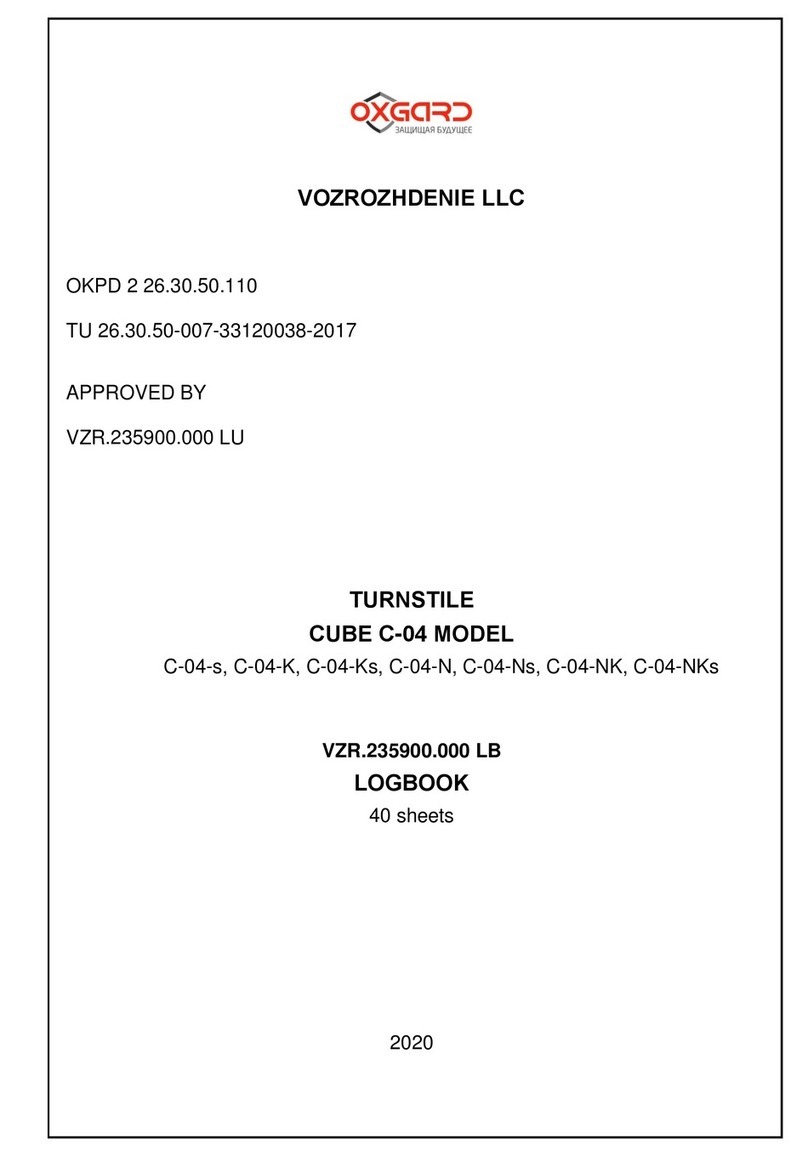iDTRONIC TTR-08 Installation and operating instructions

Electromechanical Tripod
Turnstile with Automatic
Anti-Panic Arms
Assembly and Operation Manual
TTR-08

CONTENT
1 APPLICATION.............................................................................................................3
2 OPERATION CONDITIONS........................................................................................3
3 TECHNICAL
SPECIFICATIONS
.................................................................................4
4 DELIVERY SET...........................................................................................................5
4.1 Standard delivery set .........................................................................................5
4.2 Optional equipment supplied on request............................................................5
5 BRIEF
DESCRIPTION
................................................................................................6
5.1 Main features .....................................................................................................6
5.2 Design................................................................................................................6
5.3 Control devices of the turnstile...........................................................................9
5.4 Input and output signals and their parameters when operating the turnstile ....10
5.5 Control modes of the turnstile ..........................................................................12
5.6 Operation with the RC panel ............................................................................12
5.7 Operation with the WRC ..................................................................................13
5.8 Operation with an ACS controller.....................................................................13
5.9 Additional devices connectable to the turnstile ................................................14
5.10 Emergency unblocking of the turnstile..........................................................15
5.11 Operation contingencies and response ........................................................15
6 MARKING AND
PA
CK
AGING
...................................................................................16
7 SAFETY REQUIREMENTS.......................................................................................16
7.1 Installation safety requirements .......................................................................16
7.2 Operation safety requirements.........................................................................16
8 INSTALLATION INSTRUCTIONS .............................................................................17
8.1 Installation details ............................................................................................17
8.2 Installation tools ...............................................................................................17
8.3 Length of cables...............................................................................................18
8.4 Installation procedure.......................................................................................18
9 OPERATION INSTRUCTIONS .................................................................................23
9.1 Power-up
.........................................................................................................
23
9.2 Operating modes of the turnstile at pulse control mode...................................23
9.3 Operating modes of the turnstile at potential control mode..............................25
9.4 Actions in emergency.......................................................................................25
9.5 Troubleshooting ...............................................................................................26
10 MAINTENANCE
........................................................................................................
27
11 TRANSPORTATION AND STORAGE ......................................................................28
APPENDIX 1. Control signal algorithm at pulse control mode.................................29
APPENDIX 2. Control signal algorithm at potential control mode............................31

3
Dear Customer,
instructions given in the Manual carefully, and this quality product will provide
many years of trouble-free use.
contains data that is necessary for the fullest use of operating advantages of the turnstile
as well as chapters on packaging, installation and maintenance.
Only qualified personnel, following the instructions of this Manual, must carry out
installation and maintenance.
Abbreviations:
•ACS —access control system;
•RC panel –remote control panel;
•WRC –wireless control panel;
•CLB –control logic board.
1 APPLICATION
arms (hereinafter - the turnstile) is designed for managing pedestrian flows at entrance
points of industrial facilities, banks, administrative buildings, retail outlets, railway terminals,
airports providing free passageway in emergency situations.
To ensure fast and convenient passage it is recommended to install one turnstile per 500
people working the same shift, and on the basis of maximum working load 30 persons/min
See Chapter 3 for information on the throughput capacity of the turnstile.
2 OPERATION CONDITIONS
The turnstile with regard to resistance to environmental exposure complies with
GOST15150-69, category N1 (for an outdoor application).
Operation of the turnstile is allowed at ambient air temperature from –20°C to + 50°C (up
to +55°C under the shelter) and at relative air humidity of up to 80% at +25°C.
The RC panel, included in the standard delivery set, with regard to resistance to
environmental exposure complies with GOST15150-69, category NF4 (operation in
premises with climate control).
Operation of the RC panel is allowed at ambient air temperature from +1°Сto +40°С and
at relative air humidity of up to 80% at + 25°С.
TTR-08 Electromechanical Tripod Turnstile
Assembly and Operation Manual (hereinafter - the Manual) for the
TTR-08 electromechanical tripod turnstile with automatic anti-panic folding arms
The TTR-08 electromechanical tripod turnstile with automatic anti-panic folding
Thank you for purchasing the TTR-08turnstile. Please follow the

Assembly & Operation Manual
4
3 TECHNICAL SPECIFICATIONS
Operating voltage ........................................................................................... 121.2 V DC
Consumption current
..............................................................................................
max. 6A
Power consumption
............................................................................................
max. 72 W
Throughput rate in the free passage mode ................................................. 60 persons/min
Throughput rate in the single passage mode .............................................. 30 persons/min
Passage width
........................................................................................................
500 mm
Arm rotation force ............................................................................................... max. 3 kgf
RC panel cable length .............................................................................................. 6.6 m1
Ingress Protection Rating .......................................................................... IP54 (EN 60529)
Electric shock protection class
......................................................................
III (IEC 61140)
Mean time to failure ..................................................................... min. 4,000,000 passages
Mean lifetime ........................................................................................................... 8 years
Turnstile overall dimensions (Fig. 1) ..................................................... 777×798×1084 mm
Turnstile net weight ............................................................................................. max 37 kg
Figure 1. Turnstile overall
view
1 MAX allowed cable length –40m (supplied on request).

ID GATE 6000 Electromechanical Tripod Turnstile
5
4 DELIVERY SET
4.1 Standard delivery set
Basic equipment:
Turnstile housing
..........................................................................................................
1
Hub with barrier arms and fastening ............................................................................. 1
RC panel with cable
......................................................................................................
1
Allen key SW3 to remove the cover to the
turnstile
....................................................... 1
Installation tools:
Plug
..............................................................................................................................
5
Self-adhesive cable tie mount
......................................................................................
3
Nylon cable tie 100 mm
................................................................................................
5
Technical documentation:
Certificate
.....................................................................................................................
1
Assembly and operation manual
..................................................................................
1
Package:
Box
................................................................................................................................
1
4.2 Optional equipment supplied on request
Turnstile power supply1
................................................................................................
1
WRC kit2
.......................................................................................................................
1
Intrusion detector
..........................................................................................................
1
Siren (for alerts on unauthorized entry attempts) ......................................................... 1
Anchor bolt (SORMAT PFG IR 10-15, Finland) ............................................................ 4
1 The power supply source must have load current min. 6 A within 5 sec.
2 Includes a receiver and transmitter (tag) with operation range up to 40m

Assembly & Operation Manual
6
5 BRIEF DESCRIPTION
5.1 Main features
•The turnstile is designed either for indoor application or outdoor (see Clause 2).
Turnstile housing is produced from high quality stainless steel with ABS plastic
covers.
•The turnstile plastic side covers are radio transparent that allows concealed
mounting of the ACS readers inside the turnstile housing.
•The turnstile can be operated from the RC panel or WRC as well as from an ACS.
•The turnstile is equipped with automatic anti-panic folding arms. Automatically free
of passageway is performed by bringing the barrier arm into vertical position at a
power loss or by alarm signal.
•The turnstile houses 2 LED indication displays intended for status and passage
direction indication. It also features dynamic LED indication on the front side of the
cover.
•The turnstile has outputs for connection of remote indicators.
•The turnstile has relay outputs for connection of an intrusion detector and a siren. A
purpose-designed «Fire alarm» control input is intended for unlocking the turnstile
at the fire alarm command or from emergency unblocking button.
•There are two modes for the turnstile control —a pulse control mode and a
potential control mode.
•After each passage the turnstile provides automatic complete rotation of the barrier
arm to home position, i.e. automatic reset.
•After the turn of barrier arm for more than 60º angle its reverse rotation is blocked.
•Smoothness of reset and quiet operation are ensured by a damper.
•The optical arm rotation sensors are built into the turnstile housing to ensure
accurate count of inputs to an ACS.
•The turnstile is supplied with safe voltage —maximum 14V.
•Galvanic decoupling of the outputs ensures noise-immunity of the turnstile
electronics.
5.2 Design
The design of the turnstile is shown in Fig. 2. Numbers in brackets correspond to Fig 2. of
this Manual.
The turnstile comprises a turnstile housing (1), hub (5) with three barrier arms,
RC panel (13) and additional equipment not included in standard delivery set. The turnstile
housing (1) is a formed and welded metal structure with a cover (2) containing the side
LED indication (7) and dynamic LED indication (4).
Inside the turnstile housing there are a CLB and a self-centering mechanism consisting of
a resetting device (a pusher, springs and a roller), a control mechanism with optical arm
rotation sensors and a locking device, and electromechanical barrier arm unblocking
device (automatic folding of barrier arm “anti-panic”) The self-centering mechanism also
contains a damper, an arm rotation sensor disc and a hub (5) with three barrier arms (3).
The side LED indication (located on the cover (2)) is intended for status and direction
indication: a Green Arrow indicates the direction of authorised passage (the turnstile is
open in the set direction); a Red Cross indicates ban on passage (the turnstile is locked).
The plastic side covers have highlighted zones for access card presentation. The LED
indication on the front side of the cover lights red indicating the ban on passage and
dynamic green in direction of authorised passage.

ID GATE 6000 Electromechanical Tripod Turnstile
7
Figure 2. Turnstile
components
1 –turnstile housing; 2 –cover; 3 –barrier arm;
4 –LED indication, dynamic; 5 –hub; 6 –hub fastening bolts;
7 –LED indication, side; 8 –AC power cable1; 9 –turnstile power supply
1
;
10 –emergency unblocking device (Fire Alarm)
1
;
11 –turnstile power cable1; 12 –emergency unblocking device cable
1
;
13 –RC panel (ACS controller1/ WRC
1
)
14 –cable of RC (WRC1/ ACS controller
1
);
15 –anchor bolt1; 16 –plug; 17 –cover screws.
1 Not included in standard delivery set.

Assembly & Operation Manual
8
Figure 3. RC panel overall vie
w
1, 2, 3 –buttons LEFT, RIGHT, STOP for setting the passage mode;
4, 5 –green indicators «Left», «Right»
;
6 –red indicator «Stop», 7 –RC cable.
The RC panel / WRC / ACS controller (13), emergency unblocking device Fire Alarm (10),
remote LED indicators, control mechanism and the turnstile power supply unit (9) are
connected to the CLB with the cables in accordance with the connection layout (see
Fig. 12).
The RC panel is designed as a small desktop device with a shockproof ABS plastic case
and is intended for setting and indicating operating modes when the turnstile is operated
manually. The RC panel overall view is shown in Fig. 3.
There are three control buttons on the RC front panel intended for setting the turnstile
operating modes. The LED indicators are located above the buttons. The middle button on
the RC panel (hereinafter —the STOP button) is intended to set the turnstile to the
“Always locked” mode. The left (LEFT) and the right (RIGHT) buttons are intended to
unlock the turnstile for passage in the chosen direction.
The RC panel is connected to the CLB with a multicore cable (14) via the XS1 connector
block (See Fig. 12).
If the turnstile orientation relatively to the operator’s terminal is not standard (e.g. the
terminal is placed at the backside of the turnstile housing), the RC panel orientation
towards the turnstile can be changed by exchanging places of the RC wires to the contacts
“Unlock A” and “Unlock B” as well as contacts “Led A” and “Led B” accordingly.

ID GATE 6000 Electromechanical Tripod Turnstile
9
Figure 4. Control Logic Board (CLB)
The CLB (Fig. 4) includes:
•X1 (LED), X2 (SENS), X3 (MOTOR) connectors to connect the indication module,
optical arm rotation sensors and control mechanism with a locking device (from the
X1, X2, X3 connectors with the turnstile cable);
•XT1.L (In) connector block to connect the RC panel / WRC / ACS controller inputs
as well as an emergency unblocking device (Fire Alarm) and intrusion detector;
•XT1.H (Out) connector block to connect a siren and ACS outputs, providing the
turnstile status data to the ACS controller;
•XT3 (+12VDC) connector block to connect the turnstile power supply;
•XT4 (Light A) and XT5 (Light B) connector blocks to connect “open/closed” remote
indicators, one indicator per each direction;
•XT6 (AntiPanic) connector block to connect the electromagnet of automatic
anti-panic unblocking device;
•J1 connector to select the turnstile control mode, the jumper is fixed —the pulse
control mode, the jumper is not fixed —the potential control mode. The jumper is
fixed at the factory before the delivery
•J2 connector for programming.
•Power –power LED indicator on the control board.
5.3 Control devices of the turnstile
The turnstile can be operated from the following control devices:
•the RC panel;
•the WRC;
•the ACS controller.
The above devices can be connected to the turnstile as follows:
•any device separately;
•in any combination with each other;
•all devices simultaneously (in parallel).

Assembly & Operation Manual
10
Note:
At the parallel connection of the above devices to the turnstile the superposition
of the control signals from them may occur. In that case the turnstile response will
conform to response to the obtained combination of input signals. (App. 1 and 2).
Connection of the devices is made in accordance with the connection layout (Fig. 4 and
12) by the multicore cable (14) to the out connector block XS1 that has contact leads with
connector blocks XT1.L and XT1.H of the CLB.
The RC panel is connected to the contacts GND, Unlock A, Stop, Unlock B, Led A,
Led Stop and Led B of the XS1 connector block.
The WRC is connected to the contacts GND, Unlock A, Stop and Unlock B of the XS1
connector block. Power supply of the WRC is connected to the contact +12V of the XS1
connector block.
The ACS controller outputs are connected to the contacts GND, Unlock A, Stop and
Unlock B of the XS1 connector block.
The ACS controller inputs are connected to the contacts Common, PASS A, PASS B of
the XS1 connector block and to the contacts Ready and Det Out of the XT1.H connector
block.
Pin assignments of the connector blocks are given in Fig. 12.
5.4 Input and output signals and their parameters when operating
the turnstile
The CLB microcontroller processes the incoming commands (i.e. traces the status of the
contacts “Unlock A”, “Stop”, “Unlock B” and “Fire Alarm”), keeps track of the signals from
the optical arm rotation sensors and from the intrusion detector (contact “Detector”), and
basing on those signals, generates commands to the control mechanism and to the
external devices –indication on the RC PANEL (“Led A”, “Led Stop” and “Led B”), the
signal of hub turning in the corresponding direction (“PASS A” and “PASS B”), the signal of
the turnstile ready for a current command (“Ready”), the alarm output signal (“Alarm”) —
and relays the signal of the current status of the intrusion detector (“Det Out”).
The turnstile is operated by input of a low-level signal to the XS1 connector block contacts
“Unlock A”, “Unlock B”and “Stop”relatively to the “GND”contact. As the control element
there can be used a normally open relay contact or a circuit with open collector output at
that. At the emergency the turnstile control is carried out by removing of a low-level signal
from the “Fire Alarm”contact relatively to the “GND”contact. As the control element there
can be used a normally closed relay contact or a circuit with open collector output at that
(Fig. 5 and 6).
Note:
For generating of a high-level signal at all the input contacts (Unlock A, Stop,
Unlock B, Fire Alarm and Detector) 2kOhm resistors connected to the power supply
bus “+ 5V” are used.
The control element must provide the following signal characteristics:
the relay contact as the control element:
minimum switched current, mA
...........................................................
no more than 2
closed contact resistance
(with the resistance of the connected cable), Ohm
..........................
no more than 300
the circuit with open-collector output as the control element:
voltage at the closed contact
(low - level signal at the CLB input),
V..............................................
no more than 0,8

ID GATE 6000 Electromechanical Tripod Turnstile
11
Figure 5. ACS control element —normally open relay contact
Figure 6. ACS control element —circuit with open-collector
output
The relays PASS A (contacts PASS A and Common), PASS B (contacts PASS B and
Common), Ready (contacts Ready and Common), Detector (contacts Det Out and
Common) and Alarm (contacts Alarm 1 and Alarm 2) have normally open contacts. The
“Common” contact, at that, is not connected to the CLB power supply negative terminal.
In the initial (inactive) state, when the power is on, the relay contacts “PASS A”, “PASS B”,
“Ready”and “Detector”are closed (voltage is supplied to the relay coil) and the “Alarm”
relay contacts are broken (voltage is not supplied to the relay coil).
The CLB relay operation/release is indicated by lighting up/going down of the red test
indicators located near the corresponding relays (Fig. 4).
The output cascades for PASS A, PASS B, Ready, Det Out and Alarm are the contacts
with the following signal characteristics (Fig. 7):
maximum commutation
voltage......................................................................
42V DC
maximum switched
current................................................................................
0.25A
closed contact resistance
......................................................
no more than 0.15 Ohm
Figure 7. Output cascades for PASS A, PASS B, Ready, Det Out and Alarm

Assembly & Operation Manual
12
5.5 Control modes of the turnstile
There are two modes of the turnstile control - a pulse control mode and a potential
control mode. They determine available operating modes of the turnstile (Tables 3
and 4).
The control mode is set by the jumper on the J1 connector (the J1 connector location is
shown on Fig. 4 and on a label located on the inner surface of turnstile cover (2)): the
jumper is fixed —the pulse control mode, the jumper is not fixed —the potential control
mode. The jumper is fixed at the factory before the delivery.
Control over the turnstile is effected by input of the control signal to the turnstile at both
control modes. The passage waiting time in the pulse control mode is 5 seconds
regardless of the control signal length. In the potential control mode the passage waiting
time equals the length of the control signal.
The pulse control mode is intended for the turnstile operation from the RC panel, the WRC
or the ACS controller, outputs of which support the pulse control mode.
Standard control inputs: Unlock A, Stop and Unlock B.
Special control input: Fire Alarm.
See Table 3 for the turnstile operating modes at this control mode. The algorithm of control
signals at the pulse mode is stipulated in Appendix 1.
The minimum input signal duration, when the operating mode can be changed, should be
100msec. The passage waiting time is 5 sec. and it does not depend on the input signal
duration.
See Clause 5.10 for the turnstile operation at special “Fire Alarm” control input.
The potential control mode is intended for the turnstile operation from the ACS controller,
outputs of which support the potential control mode (for example, a lock controller).
Standard control inputs: Unlock A and Unlock B.
Special control inputs: Stop and Fire Alarm.
See Table 4 for the turnstile operating modes at this control mode. The algorithm of control
signals at this mode is stipulated in Appendix 2.
The minimum input signal duration, when the operating mode can be changed, should be
100msec. The passage waiting time is equal to the low-level signal duration (the turnstile
remains open in the set direction if a low-level signal exists at the set direction input by the
moment of passage).
At the low-level signal inputting to the “Stop”input, both directions are locked for the time of
the signal duration regardless the signal strength at the inputs “Unlock A”and “Unlock B”.
At the low-level signal removing from the “Stop”input, the directions are set to the control
mode according to the signal strength at the inputs “Unlock A”and “Unlock B”.
See Clause 5.10.for the turnstile operation at the special “Fire Alarm” control input.
5.6 Operation with the RC panel
When the buttons on the RC panel are pressed (the STOP button and the two other
buttons corresponding to the passage direction), the closing of the relevant contact “Stop”,
“Unlock A”or “Unlock B”to the contact “GND”occurs (i.e. forming of the low-level signal
relatively to the contact “GND”).

ID GATE 6000 Electromechanical Tripod Turnstile
13
Operation logic of the turnstile at the single passage in the A(B) direction at the pulse
control mode:
1. When the button, corresponding to the A (B) passage direction, is pressed on the
RC panel, the closing of the contact “Unlock A(B)” to the contact “GND”occurs (i.e.
forming of the low-level signal on the contact “Unlock A(B)” relatively to the contact
“GND”).
2. The CLB microcontroller processes the incoming command and generates the
command to the control mechanism, which opens the A (B) passage direction (lifts
the upper (lower) edge of the key holt).
3. The microcontroller traces the status of the optical arm rotation sensors, which
become active/passive in a certain consequence at the barrier arm rotation, and
counts the time passed since the moment of pushing the RC button corresponding
to the permitted passage direction A (B).
4. At the barrier arms turning at 67° the microcontroller forms signal “PASS A (B)”
(breaking the contacts “PASS A (B)” and “Common” takes place).
5. After the barrier arms turning at 67° or after 5 seconds since the moment of pushing
the RC button corresponding to the permitted passage direction A (B), the
microcontroller generates a command to the control mechanism, which closes the
passage direction A (B) (drops down the upper (lower) edge of the key holt).
6. When the barrier arms reset to home position (barrier arms turning at 112°), the
microcontroller removes the signal “PASS A (B)” (contacting the “PASS A (B)” and
“Common” takes place).
The “Always free” operating mode particularity: in this mode the command described in
step 5 is not generated and the set passage direction remains open.
5.7 Operation with the WRC
Control over the turnstile with the WRC is similar to that with the RC panel.
The buttons on the WRC tag act the same way as those on the RC panel.
The WRC operation manual is supplied with that device.
5.8 Operation with an ACS controller
In the pulse control mode control over the turnstile with an ACS controller is similar to that
with the RC panel.
In the potential control mode control over the turnstile with an ACS controller is similar to
that with the RC panel and lies in forming of low-level signal on the contacts “Unlock A”,
“Stop” and “Unlock B” relatively to the contact “GND”.
The difference of the operation logic in the potential control mode and in the pulse control
mode (as per Clause 5.6): the command to the control mechanism, which closes the
passage is generated only at the moment of releasing the RC button, corresponding to the
passage direction A(B).
Therefore, for arranging single passages in the potential control mode it is recommended
to remove the control low-level signal at the beginning of the “PASS”signal for the
corresponding direction.
The passage through the turnstile in the A (B) direction is fixed in accordance with the
status of the output contacts “PASS A(B)” and “Common”.

Assembly & Operation Manual
14
5.9 Additional devices connectable to the turnstile
The following external devices can be connected to the turnstile:
•intrusion detector;
•siren;
•emergency unblocking device “Fire Alarm” (10);
•remote indicators.
The intrusion detector is connected to the XT1.L, connector block, and the siren is
connected to the XT1.H connector block of the CLB according to the connection layout
(Fig. 4 and Fig. 12). There should be normally closed contacts on the intrusion detector.
In case the intrusion detector is not connected, there should be placed a jumper between
the contacts Detector and GND of the XT1.L connector block. The jumper is delivered with
the initial settings.
Caution!
Installation of the intrusion detector is made in accordance with the passage zone
layout and climatic resistance of the detector.
If the turnstile is locked (the “Always locked”mode /“Both directions closed”mode when
both directions are locked, Tables 3 and 4) and a signal comes from the intrusion detector,
the “Alarm”signal is generated. The “Alarm” signal is disabled after 5 sec. or by executing
of any received command. The signal from the intrusion detector is ignored for the period
of authorized unlocking of the turnstile in either or both directions.
If within 3 sec. after the “Always locked”/“Both directions closed”mode is set, the signal
from the intrusion detector comes, it is also ignored.
The intrusion detector status signal is constantly transmitted to the “Det Out” and
“Common” contacts of the CLB XT1.H connector block (Fig. 4).
The emergency unblocking device is connected to the contacts “Fire Alarm”and “GND” of
the out connector block XS1 that has contact leads with XT1.L connector block of the CLB
in accordance with the connection layout (Fig. 4 and Fig. 12). If the “Fire Alarm”input is
not used, it is necessary to set a jumper between the contacts “Fire Alarm”and “GND”.
This jumper is preset at the factory. Operation of the turnstile under commands of the
emergency unblocking device is stipulated in clause 5.10.
The remote indicators are connected to the connector blocks XТ4 (Light A) and
XТ5 (Light B). At that the “Light A”(“Light B”) relay is active (the voltage is supplied to the
relay coil), when the “Green arrow” pictogram on the LED indication display, corresponding
to the set passage direction, lights, and it is passive, when the “Green arrow” pictogram on
the Led display does not light. The response/release of the relays “Light A” and “Light B”
can be defined according to lighting up/going down of the red indicators, which are
installed near the above mentioned relays (Fig. 4).
Output cascades for the “Light A” and the “Light B” relays are nonbridging relay contacts
(Fig. 8) with the following signal characteristics:
maximum switched voltage .......................................................................... 30 VDC
maximum switched voltage
...........................................................................
42 VAC
maximum switched AC/DC................................................................................... 3 A
closed contact resistance .................................................... no more than 0.15 Ohm

ID GATE 6000 Electromechanical Tripod Turnstile
15
Figure 8. Output cascades for Light A and Light B
5.10 Emergency unblocking of the turnstile
Emergency unblocking of the turnstile is performed by input of the “Fire Alarm”signal to
the turnstile. At that the barrier arm automatically falls down ensuring free passage. Green
indication with momentary changing into red will be activated on the side LED indication
and dynamic LED indication.
If the Fire Alarm signal is received while the hub with folding arms is rotating, the flashing
of the indication will be activated, but the emergency unblocking function will be activated
only after the rotation is finished
Automatic anti-panic function is also activated at a power supply loss, e.g. breakdown of
connected power supply unit.
After restore of power supply or Fire Alarm signal removal the arm shall be manually set
into operating position, after that the turnstile is ready for further standard operation.
5.11 Operation contingencies and response
The turnstile is capable of providing information on the following operation contingencies:
•unauthorized access;
•passage delay for more than 30 sec.;
•one or both optical arm rotation sensors are out of order.
A special signal “Ready” is generated in each of the above cases.
In case of unauthorized access the “Ready”signal is formed as follows: at 8° arm rotation
one of the optical sensors (Fig. 14) responds and the output contacts “Ready” and
“Common”get broken (the beginning of the signal). When the barrier arms reset to home
position, the both optical sensors become passive and the output contacts “Ready”and
“Common” get closed (the finish of the signal).
In case of delay of an authorized passage for more than 30 sec. the signal “Ready”is
formed as follows: if within 30 seconds from the moment of passage commencing, which is
determined by the arm rotation at no less than 8° (i.e. activation of one of the optical
sensors), the reset of barrier arms to home position does not happen, the output contacts
“Ready”and “Common”break (the beginning of the signal). When the barrier arms reset to
home position, the both optical sensors become passive and the output contacts “Ready”
and “Common” are closed (finish of the signal).
When one or both of the optical sensors become out of order, the output contacts “Ready”
and “Common”get broken (the beginning of the signal “Ready”). After fault removal the
closed status of the contacts “Ready” and “Common” is renewed.

Assembly & Operation Manual
16
6 MARKING AND PACKAGING
The turnstile has the marking on the turnstile housing in the form of a label located on the
inner panel of the turnstile housing. The label contains manufacturer’s trademark and
contact details, year and month of production, operating voltage and power consumption
of the turnstile.
To get access to the label it is necessary to take off the turnstile cover (2) in the following
way:
1. Unscrew the fixing bolts of the cover (17) using the Allen key S3.
2. Carefully lift up the cover and release from fasteners by moving it in passage
direction. Please pay attention for not to break the inner cables.
3. Separate the cable S1 connector connecting the cover with turnstile housing.
4. Carefully take off the cover and lay it on a plain and steady ground.
The complete delivery set of the turnstile (Clause 4.1) is packed in a transportation box,
which keeps it undamaged during the transportation and storage.
Transportation box dimensions (L × H × W) ................................. 1190×450×420 mm
Transportation box weight (gross) ................................................ no more than 53 kg
7 SAFETY REQUIREMENTS
7.1 Installation safety requirements
The installation should be carried out only by the qualified personnel after careful study of
this Manual.
Warning!
•All the cables should be connected up when the power supply is switched off
from the AC mains.
•Only serviceable tools should be used for installation.
•Observe general electrical safety rules when laying out the cables.
•Before the turnstile first power on make sure its installation and connection have
been made accordingly.
Power supply unit installation must be made in accordance with the safety rules stipulated
in its certificate.
7.2 Operation safety requirements
Observe general electrical safety rules when operating the turnstile.
Warning!
•Do not use the turnstile under conditions that do not comply with the
requirements of Chapter 2 of this Manual.
•Do not use the turnstile at supply voltage that does not comply with the
requirements of Chapter 3 of the Manual.
Safety requirements on the power supply units operation are shown in their certificates.

ID GATE 6000 Electromechanical Tripod Turnstile
17
8 INSTALLATION INSTRUCTIONS
Follow the safety requirements during the installation (see Clause 7.1)
8.1 Installation details
Correct turnstile installation provides its functionality and lifetime. Please carefully study
and follow the installation instructions.
It is recommended:
•to mount the turnstile on steady and level concrete (grade 400 or higher), stone or
similar foundations at least 150mm thick;
•to level the foundation so that the anchoring points of the turnstile lie in the same
plane;
•to apply reinforcing elements (400×400×300mm) for installation on less steady
foundation (frame foundation, for example).
To ensure accurate passage tracking, when the turnstile is operated from an ACS, it is
recommended to create the passage area in such a way that the barrier arms should turn
in the direction of movement at the angle no less than 70° (Fig. 9).
Figure 9. Site preparation. Recommendations
The turnstile is equipped with the resetting device that operates as follows:
o at the barrier arm turning at the angle of more than 60°±5° the reset is effected in
the direction of movement and the turn of barrier arm to counter direction is not
possible (blocking of return passage) ;
o at the barrier arm turning at the angle less than 60°±5° the reset is effected
in the counter to the movement direction (reset to home position).
When planning the passage area, it is necessary to arrange additional emergency exit. For
example, it can be the automatic rotary section BH-02 (Clause 9.4).
8.2 Installation tools
•1.2÷1.5 kW hammer drill;
•Ø16 mm hard-alloyed drill bits;
•Floor chaser for electric raceway;
•Flat slot screwdriver No.2;
•Cross-head screwdriver;

Assembly & Operation Manual
18
•Horn-type and socket wrenches: S17, S13 and S10;
•Set square 90º;
•Allen key S3;
•Level;
•Measuring tape (2 m);
•Hard wire 1.5 m long for cable pulling;
•Slide caliper.
Note:
It is allowed to use other testing equipment and measuring tools provided
the equipment in use ensures the required parameters and measurement accuracy.
8.3 Length of cables
Table 1. Cables, used at the installation
№
Cable
length,
m,
max
Cable type
Cross-
section,
mm,
min
Equipment
Example
1
Power supply
10
Twin cable
1.5
AWG 15; HO5VV-F 2×1.5
15
Twin cable
2.5
AWG 13; HO5VV-F 2×2.5
2
- Fire Alarm
- Optional equipment to control
board input and output
30
Twin cable
0.2
RAMCRO
SS22AF-T 2×0.22
CQR-2
3
RC panel
40
Eight core cable
0.2
CQR CABS8 8×0.22c
4
ACS controller
30
Six core cable
0.2
CQR CABS6 6×0.22c
8.4 Installation procedure
Caution!
The Manufacturer does not incur liability for the damage to the turnstile and other
equipment and other losses resulting from the turnstile incorrect installation and no
claims from the Customer are accepted if the installation is made without following
the instructions of the given Manual.
The turnstile connection layout is given in Fig. 12. The CLB connectors location is shown
in Fig. 4. Cables parameters and their length are given in clause 8.3. The installation
surface and passage area recommendations are given in clause 8.1.
1. Unpack the turnstile check the completeness as per Chapter 4.
2. Make the holes for anchor bolt (15) sleeves for the turnstile housing installation
(Fig. 10).
3. Install the turnstile power supply unit (9) in its place (See power supply unit
certificate for installation procedure of the turnstile power supply).
4. If you lay out cables under the floor surface, make an electric raceway to the cables
entry zone of the turnstile housing (shown in Fig. 10).
5. Insert sleeves for anchor bolts into the holes so that they do not stick out above the
floor surface.
6. Remove the cover (2) in order given in Chapter 6.
7. Remove the reinforcement plate (see Fig. 11). To do so first loosen 4 fixing screws
of the plate with the flat slot screwdriver.

ID GATE 6000 Electromechanical Tripod Turnstile
19
Figure 10. Floor anchor position and cable entries for housing
installation
(turnstile housing is
dotted)
Figure 11. Turnstile with cover removed
1 –reinforcement plate; 2 –fixing screws of reinforcement plate;
3 –turnstile housing; 4 –back panel; 5 –readers installation place
8. Remove the back panel of the turnstile. To do so move it up along the turnstile
housing until it is unengaged from the housing. The back panel is equipped with two
pairs of engagement grips located on its upper and lower part.
Caution!
Fix the housing after laying the cables in the electric raceway and inside the
turnstile housing. Be careful and prevent the turnstile from falling before it is fixed.
9. Lay the cables in the electric raceway and inside the turnstile housing.

Assembly & Operation Manual
20
10. Install the turnstile housing on anchor sleeves and fix it with M10 bolts using S17
socket wrench. Check the position of the housing with the level.
11. If it is necessary to set up the turnstile into potential control mode remove the
jumper on the J1 connector of the CLB.
12. Connect the RC panel cable (14) (WRC / ACS controller) to XS1 connector block.
13. Connect the additional equipment if necessary (intrusion detector and a siren;
emergency unblocking device (Fire Alarm); remote indicators).
14. Connect the power cable (11) from the turnstile power supply to XS1 connector
block.
15. If needed, install the proximity card readers into the special places, situated in the
housing (5 in Fig. 11). To connect card readers use free contacts (15 - 24) of the
XS1 connector block.
Caution!
In order to install readers, manufactured by other companies, please note that they
are to comply with the following characteristics:
dimensions (length × width × height) ..................................... max 145×90×25 mm
card reading distance ........................................................................... min 70 mm
In case of use of card readers with read range fewer than 7cm, the steady reading
of cards during their validation is not guaranteed5.
16. Check serviceability and accuracy of all the electrical connections. Fasten all the
cables in two points to the hole in the turnstile housing horizontal plane, using hook
and loop cable ties.
17. Install the back panel in reversed order.
18. Install the reinforcement plate on the turnstile in reversed order.
19. Connect the indication board cable header to the S1 connection slot.
20. Mount the cover with LED indication back into its place in the reverse order. When
the cover with LED indication mounting is carried out correctly it does not need
much effort. Fasten the cover with the bolts.
21. Install the hub (5) with the barrier arms (3) in the following order:
•Insert the hub into a corresponding mounting face on the turnstile mechanism shaft.
Caution!
For proper hub installation before the final tightening of the bolts, barrier arm is to be
shifted into a horizontal position and a 90º degree angle in the horizontal between
the barrier arm and the turnstile housing is to be set with a set square.
•Fix the hub with hub fastening bolts (6), inserting a split washer under each bolt
head. Bolts’ tightening is to provide solid hub fixation regarding the turnstile
mechanism shaft (without gaps and mismatches).
22. Install the plugs (16).
Run a test switch on of the turnstile as specified in clause 9.1 «Power-up».
5 IDTRONIC produces IP-based entrance control systems KT-08.3A with similar design which has
got built-in ACS controller and built-in card-readers. Their read range is at least 6 cm from
the turnstile's cover.
Table of contents
Other iDTRONIC Turnstile manuals

